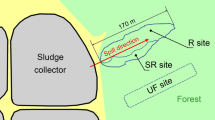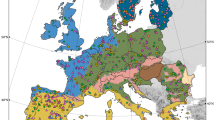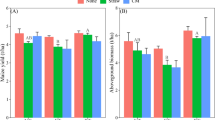Abstract
Animals that modify their physical environment by foraging in the soil can have dramatic effects on ecosystem functions and processes. We compared bacterial and fungal communities in the foraging pits created by bilbies and burrowing bettongs with undisturbed surface soils dominated by biocrusts. Bacterial communities were characterized by Actinobacteria and Alphaproteobacteria, and fungal communities by Lecanoromycetes and Archaeosporomycetes. The composition of bacterial or fungal communities was not observed to vary between loamy or sandy soils. There were no differences in richness of either bacterial or fungal operational taxonomic units (OTUs) in the soil of young or old foraging pits, or undisturbed soils. Although the bacterial assemblage did not vary among the three microsites, the composition of fungi in undisturbed soils was significantly different from that in old or young foraging pits. Network analysis indicated that a greater number of correlations between bacterial OTUs occurred in undisturbed soils and old pits, whereas a greater number of correlations between fungal OTUs occurred in undisturbed soils. Our study suggests that digging by soil-disturbing animals is likely to create successional shifts in soil microbial and fungal communities, leading to functional shifts associated with the decomposition of organic matter and the fixation of nitrogen. Given the primacy of organic matter decomposition in arid and semi-arid environments, the loss of native soil-foraging animals is likely to impair the ability of these systems to maintain key ecosystem processes such as the mineralization of nitrogen and the breakdown of organic matter, and to recover from disturbance.
Similar content being viewed by others
Log in or create a free account to read this content
Gain free access to this article, as well as selected content from this journal and more on nature.com
or
References
Anderson MJ, Gorley RN, Clarke KR . (2008). PERMANOVA+ for PRIMER: guide to software and statistical methods. PRIMER-E: Plymouth, UK.
Ardley JK, Parker MA, De Meyer SE, Trengove RD, O'Hara GW, Reeve WG et al. (2012). Microvirga lupini sp. nov., Microvirga lotononidis sp. nov. and Microvirga zambiensis sp. nov. are alphaproteobacterial root-nodule bacteria that specifically nodulate and fix nitrogen with geographically and taxonomically separate legume hosts. Int J System Evol Microb 62: 2579–2588.
Assenov Y, Ramirez F, Schelhorn SE, Lengauer T, Albrecht M . (2008). Computing topological parameters of biological networks. Bioinformatics 24: 282–284.
Austin AT, Vivanco L . (2006). Plant litter decomposition in a semi-arid ecosystem controlled by photodegradation. Nature 442: 555–558.
Bachar A, Al-Ashhab A, Soares MIM, Sklarz MY, Angel R, Ungar ED, Gillor O . (2010). Soil microbial abundance and diversity along a low precipitation gradient. Microb Ecol 60: 453–461.
Benjamini Y, Hochberg Y . (1995). Controlling the false discovery rate: a practical and powerful approach to multiple testing. J Royal Stat Soc Ser B 57: 289–300.
Bissett A, Brown MV, Siciliano SD, Thrall PH . (2013). Microbial community responses to anthropogenically induced environmental change: towards a systems approach. Ecol Lett 16: 128–139.
Brito I, Goss MJ, de Carvalho M, Chatagnier O, van Tuinen D . (2010). Impact of tillage system on arbuscular mycorrhiza fungal communities in the soil under Mediterranean conditions. Soil Till Res 121: 63–67.
Chaffron S, Rehrauer H, Pernthaler J, von Mering C . (2010). A global network of coexisting microbes from environmental and whole-genome sequence data. Genome Res 20: 947–959.
De Cáceres M, Legendre P . (2009). Associations between species and groups of sites: indices and statistical inference. Ecology 90: 3566–3574.
De Cáceres M, Legendre P, Wiser SK, Brotons L . (2012). Using species combinations in indicator analyses. Method Ecol Evol 3: 973–982.
Edgar RC, Haas BJ, Clemente JC, Quince C, Knight R . (2011). UCHIME improves sensitivity and speed of chimera detection. Bioinformatics 27: 2194–2200.
Eldridge DJ, Mensinga A . (2007). Foraging pits of the Short-Beaked Echidna (Tachyglossus aculeatus) as small-scale patches in a semi-arid Australian box woodland. Soil Biol Biochem 39: 1055–1065.
Eldridge DJ, Leys JF . (1999). Wind dispersal of the vagant lichen Chondropsis semiviridisin semi-arid eastern Australia. Aust J Bot 47: 157–164.
Eldridge DJ, Koen TB . (1998). Cover and floristics of microphytic soil crusts in relation to indices of landscape health. Plant Ecol 137: 101–114.
Eldridge DJ, Koen TB, Huang N, Killgore A, Whitford WG . (2012). Animal foraging as a mechanism for sediment movement and soil nutrient development: evidence from the semi-arid Australian woodlands and the Chihuahuan Desert. Geomorph 157/158: 131–141.
Filson RB, Rogers RW . (1979). Lichens of South Australia. Govemment Printer: South Australia.
Geluso K . (2005). Benefits of small-sized caches for scatter-hoarding rodents: influence of cache size, depth, and soil moisture. J Mammal 86: 1186–1192.
Haslem A, Kelly LT, Nimmo DG, Watson SJ, Kenny SA, Taylor RS et al. (2011). Habitat or fuel? Implications of long-term, post-fire dynamics for the development of key resources for fauna and fire. J Appl Ecol 48: 247–256.
Houbraken J, Samson RA . (2011). Phylogeny of Penicillium and the segregation of Trichocomaceae into three families. Studies Mycol 70: 1–51.
Jacobsen KM, Jacobsen PJ . (1998). Rainfall regulates decomposition of buried cellulose in the Namib Desert. J Arid Environ 38: 571–583.
James AI, Eldridge DJ . (2007). Reintroduction of fossorial native mammals and potential impacts on ecosystem processes in an Australian desert landscape. Biol Conserv 138: 351–359.
James AI, Eldridge DJ, Hill BM . (2009). Foraging animals create fertile patches in an Australian desert shrubland. Ecography 32: 723–732.
James AI, Eldridge DJ, Moseby KE . (2010). Foraging pits, litter, and plant germination in an arid shrubland. J Arid Environ 74: 516–520.
James AI, Eldridge DJ, Koen TB, Moseby KE . (2011). Can the invasive European rabbit (Oryctolagus cuniculus) assume the soil engineering role of locally-extinct natives? Biol Invas 13: 3027–3038.
Johnson C . (2006) Australia’s mammal extinctions: a 50000 year history. Cambridge University Press: Melbourne.
Jones CG, Lawton JH, Shachak M . (1994). Organisms as ecosystem engineers. Oikos 69: 373–386.
Jones CG, Gutierrez JL, Byers JE, Crooks JA, Lambrinos JG, Talley TS . (2010). A framework for understanding physical ecosystem engineering by organisms. Oikos 119: 1862–1869.
Kuske CR, Yeager CM, Johnson S, Ticknor LO, Belnap J . (2012). Response and resilience of soil biocrust bacterial communities to chronic physical disturbance in arid shrublands. ISME J 6: 886–897.
Lavelle P, Daecans T, Aubert M, Barot S, Blouin M, Bureau F et al. (2006). Soil invertebrates and ecosystem services. Eur J Soil Biol 42: S3–S15.
Li H, Xing P, Chen M, Bian Y, Wu QL . (2011). Short-term bacterial community composition dynamics in response to accumulation and breakdown of Microcystis blooms. Water Res 45: 1702–1710.
Lucero ME, Unc A, Cooke P, Dowd S, Sun S . (2011). Endophyte microbiome diversity in micropropagated Atriplex canescens and Atriplex torreyi var griffithsii. PLoS One 6: e17693.
Neubert MG, Caswell H, Solow AR . (2009). Detecting reactivity. Ecology 90: 2683–2688.
Quince C, Lanzen A, Davenport RJ, Turnbaugh PJ . (2011). Removing noise from pyrosequenced amplicons. BMC Bioinf 12: 38.
Robley AJ, Short J, Bradley S . (2001). Dietary overlap between the burrowing bettong and the European rabbit in semi-arid coastal Western Australia. Wildl Res 28: 341–349.
Ruiz-Moreno D, Pascual M, Riolo R . (2006). Exploring network space with genetic algorithms: modularity, resilience and reactivity. In: Pascual M, Dunne JA (eds), Ecological networks: linking structure to dynamics in food webs. Oxford University Press: UK, pp 187–208.
Schalamuk S, Velázquez S, Cabello M . (2013). Dynamics of arbuscular mycorrhizal fungi spore populations and their variability under contrasting tillage systems in wheat at different phonological stages. Biol Agric Hortic 29: 38–45.
Schloss PD, Westcott SL, Ryanbin T, Hall JR, Hartmann M, Hollister EB et al. (2009). Introducing mothur: open-source, platform-independent, community-supported software for describing and comparing microbial communities. Appl Environ Micro 75: 7537–7541.
Schloss PD, Westcott SL . (2011). Assessing and improving methods used in operational taxonomic unit-based approaches for 16 S rRNA gene sequence analysis. Appl Environ Micro 77: 3219–3226.
Smith HD . (1948). Biological control of citrus insects. In: Webber HJ, Batchelor LD (eds), The citrus industry The production of the crop Vol. II. California Press: USA, pp 597–626.
Spatafora JW, Sung GH, Johnson D, Hesse C, O'Rourke B, Serdani M et al. (2006). A five-gene phylogeny of Pezizomycotina. Mycologia 98: 1018–1028.
Steinberger Y, Whitford WG . (1983). The contribution of rodents to decomposition processes in a desert ecosystem. J Arid Environ 6: 177–182.
Sun MY, Dafforn KA, Johnston EL, Brown MV . (2013). Core sediment bacteria drive community response to anthropogenic contamination over multiple environmental gradients. Environ Micro 15: 2517–2531.
Vossbrinck CR, Coleman DC, Woolley TA . (1979). Abiotic and biotic factors in litter decomposition in a semiarid grassland. Ecology 60: 265–271.
Wallwork JA, Kamill BM, Whitford WG . (1985). Distribution and diversity patterns of soil mites and other microarthropods in a Chihuahuan desert site. J Arid Environ 9: 215–231.
Wang Q, Garrity GM, Tiedje JM, Cole JR . (2007). Naive Bayesian classifier for rapid assignment of rRNA sequences into the new bacterial taxonomy. Appl Environ Micro 73: 5261–5267.
Weisburg WG, Barns SM, Pelletier Da, Lane DJ . (1991). 16 S ribosomal DNA amplification for phylogenetic study. J Bacteriol 173: 697–703.
Whitford WG . (2002) Ecology of Desert Systems. Elsevier Science: London.
Whitford WG, Kay FR . (1999). Biopedturbation by desert mammals: a review. J Arid Environ 41: 203–230.
Woinarski JCZ, Burbidge AA, Harrison PL . (2012) The Action Plan for Australian Mammals, 2012 CSIRO Publishing: Melbourne, Australia.
Wollenzien U, Hoog GS, Krumbein WE, Uijthf JMJ . (1997). Sarcinomycespetricola, a new microcolonial fungus from marble in the Mediteranean Basin. Antone van Leeuwenhoek 71: 281–288.
Yeager CM, Kornosky JL, Housman DC, Grote EE, Belnap J, Kuske CR . (2004). Diazotrophic community structure and function in two successional stages of biological soil crusts from the Colorado Plateau and Chihuahuan Desert. Appl Environ Micro 70: 973–983.
Zhu WY, Zhao LX, Zhao GZ, Duan XW, Qin S, Li J et al. (2012). Plantactinospora endophytica sp. nov., an actinomycete isolated from Camptotheca acuminata Decne., reclassification of Actinaurispora siamensis as Plantactinospora siamensis comb. nov. and emended descriptions of the genus Plantactinospora and Plantactinospora mayteni. Int J Syst Evol Micro 62: 2435–2442.
Acknowledgements
We thank Ivan Wong for field assistance and Samantha Travers for comments on an earlier draft of the manuscript. We acknowledge the considerable financial, logistic and technical support provided by the Australian Wildlife Conservancy through their Scotia Sanctuary. This research was supported by the Australian Government under ARC LP0882630.
Author information
Authors and Affiliations
Corresponding author
Ethics declarations
Competing interests
The authors declare no conflict of interest.
Additional information
Supplementary Information accompanies this paper on The ISME Journal website
Supplementary information
Rights and permissions
About this article
Cite this article
Eldridge, D., Woodhouse, J., Curlevski, N. et al. Soil-foraging animals alter the composition and co-occurrence of microbial communities in a desert shrubland. ISME J 9, 2671–2681 (2015). https://doi.org/10.1038/ismej.2015.70
Received:
Revised:
Accepted:
Published:
Issue date:
DOI: https://doi.org/10.1038/ismej.2015.70
This article is cited by
-
Recurring heavy rainfall resulting in degraded-upgraded phases in soil microbial networks that are reflected in soil functioning
Soil Ecology Letters (2023)
-
Foraging pit location provides valuable insights into critical habitat requirements of soil engineers
Landscape Ecology (2023)
-
A reintroduced ecosystem engineer provides a germination niche for native plant species
Biodiversity and Conservation (2020)
-
Digging mammal reintroductions reduce termite biomass and alter assemblage composition along an aridity gradient
Oecologia (2019)
-
Keystone taxa as drivers of microbiome structure and functioning
Nature Reviews Microbiology (2018)



